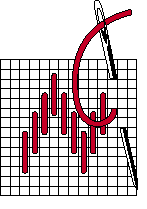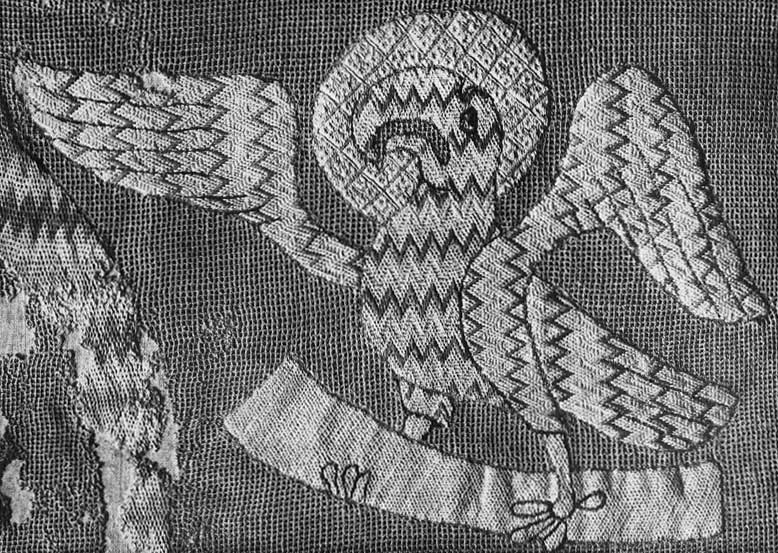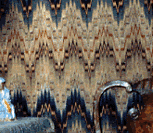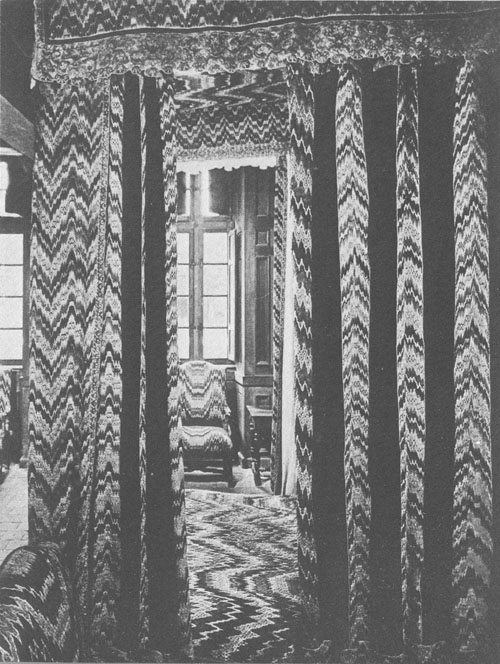- by Sabrina de la Bere,
Guild Patron
Defining terms:
To determine whether or not Bargello is period, we need to begin with definitions to ensure we are all talking about the same concepts.
"PERIOD"
The SCA by definition covers "pre-17th C European history." Thus, if we can find examples of needlework that can be dated 1600 A. D. or before, it can be considered period in the strictest sense. There are a couple of examples which we will discuss that may meet this criterion
There is also the sometimes confusing "heraldic" rule of thumb which states as follows: if a person living 1650 or before has a name, that name can be considered period; since it may be presumed that the person was born in 1600 or before. Thus, the confusion as to what is "period." If we adopt the year 1650, there are many examples of Bargello that are "period." However, anyone entering an A&S contest should consult with the organizers before presuming their entry would be considered appropriate
"BARGELLO"
Bargello is a term that the popular needlepoint press uses to refer to a wide variety of patterns achieved through the use of upright stitches. The term has also come to mean a particular sense of patterning and color. Most of these patterns were developed in the 17th - 18th - 19th and 20th Centuries in various waves of popularity of this needlepoint/canvas work technique
Pages have been written on the origins of the term Bargello. There are many conflicting stories that involve Hungarian nobility, the Medicis, and the Florentine prison known as the "Bargello." Rather than spend space here trying to unravel the origins of the name and the names of the underlying stitches, I will refer you to an article in Piecework magazine from January/February 1996 for further reading. For the remainder of this article, I will refer to the types of stitches and patterns that were part of its earliest evolution
STRAIGHT GOBELIN STITCH
(also called brick stitch) is "satin stitches worked parallel to the warp or weft of the ground material forming straight lines which serve as a filling pattern; the effect resembles that of a woven tapestry, and the stitch is called - applying a comparatively modern name to a much older technique - Gobelin stitch. Variants arise when the stitches are offset, like bricks, or in groups of 2 or 3." [Schuette pg. X]
To work Gobelin or Brick Stitch you proceed along the line of stitching. Between each stitch you leave space for a stitch on the return journey. When there is no "line of stitching" the stitching method may become more like Florentine with each stitch making the jump up or down to the next level and placed next to each other rather than spaced.
FLORENTINE STITCH
 (also called Flame Stitch, Irish Stitch, Long and Short stitch, straight stitch, cushion stitch) - stitches of the same length that are worked parallel to the warp of the ground fabric, where each stitch proceeds up or down the same number of threads. The evenness of the stitching creates a woven affect that is extremely long wearing
(also called Flame Stitch, Irish Stitch, Long and Short stitch, straight stitch, cushion stitch) - stitches of the same length that are worked parallel to the warp of the ground fabric, where each stitch proceeds up or down the same number of threads. The evenness of the stitching creates a woven affect that is extremely long wearing
To work Florentine Stitch you proceed along the line of the stitching, filling every space between threads, and moving up or down depending on the pattern. When working up, stitch from bottom to top. When working down, stitch from top to bottom. The pattern derives from the evenness of stitch length being repeated as well as from the variety of colors used. Also, with Florentine, the repeat patterns follow through out the work without variation and only truncated at edges of the fabric.
For many of the earlier pieces the pattern is over 4 threads with the move to the next stitch being 2 threads up or 2 threads down - a 4:2 step pattern.
HUNGARIAN POINT
 (also called Point de Hongrie, Point d'Hongrie, Punto Unghario, Hungarian Ground) - stitches of various length that are worked parallel to the warp of the ground fabric, where each stitch proceeds up or down to create a pattern. The number of threads covered, not only may vary from stitch to stitch but from line to line. The finished effect is like a woven fabric
(also called Point de Hongrie, Point d'Hongrie, Punto Unghario, Hungarian Ground) - stitches of various length that are worked parallel to the warp of the ground fabric, where each stitch proceeds up or down to create a pattern. The number of threads covered, not only may vary from stitch to stitch but from line to line. The finished effect is like a woven fabric
To work Hungarian Point you proceed along the line of the stitching, filling every space between threads, and moving up or down depending on the pattern. When working up, stitch from bottom to top. When working down, stitch from top to bottom. The pattern will derive from the variety in stitch lengths and from the variety of colors used.
A Possible Evolution
From Brick Stitch to Florentine Stitch and Hungarian Point
Brick stitch was frequently used in the 13th and 14th Centuries on ecclesiastical garments and church linens in Lower Saxony [Schuette pg. X]. We also see it on church linens and garments in the 14th and 15th C in multi-color bands from Westphalia [Wymarc]. In both time frames and places, the stitches are done in geometric patterns.
Some of the altar curtains shown in Schuette, which have brick stitch, contain areas done in a "zigzag" or "flame" pattern. [Schuette pg. 94-95, pl 147-150]; such as on the eagle shown here on p.3, Barbara Snook notes that the zigzag patterns on the chest and wings are done in a 4:2 step pattern while the lower branch is of brick stitch [Snook pg. 16]. Thus, we can establish the underlying elements for Florentine Stitch in the same area and within the same time frame as brick stitch; and specifically brick stitch worked in an irregular pattern.

Detail of the eagle of Saint John. Part of an altar curtain, Halberstadt Cathedral Museum. Lower Saxony. Late 13th-Early 14th C.
In the fifteenth century, satin stitch also evolves. Stitches begin to have overlapping colors and various lengths creating shading effects. You also begin to have multiple hues of the same color used next to each other in the same design as in the Elizabethan raised worked coifs and jackets. These color elements become a key part of Florentine Stitch and Hungarian Point
Hungarian Point seems to take the more geometric steps seen in the earlier brick stitch patterns and extends them further. In the pieces where the irregular brick stitch patterns are used as bands, the geometric patterns include points, zigzags, diamonds, double points and other patterns that are familiar to Hungarian Point. The key differences appear to be the use of color within the patterns and the sense of repeating bands that come to characterize Hungarian Point.
Existing Textiles Dating 1600 or Before
FLAME STITCH WALL HANGINGS 1560-85:
 In the West Room at Parham Park is a set of hangings made of wool yarn and linen scrim. They are described as consisting "of 5 lengths of linen scrim, with a flame stitch design worked all over in a knitted-or-chain-type stitch, in a large scale zig-zag design repeating shades of blue, brown, fawn, yellow, beige, red and orange in woolen yarn." [Parham pg. 9] They are Italian and have been dated 1560-85. They are further noted as being one of the earliest examples of Flame Stitch in England
In the West Room at Parham Park is a set of hangings made of wool yarn and linen scrim. They are described as consisting "of 5 lengths of linen scrim, with a flame stitch design worked all over in a knitted-or-chain-type stitch, in a large scale zig-zag design repeating shades of blue, brown, fawn, yellow, beige, red and orange in woolen yarn." [Parham pg. 9] They are Italian and have been dated 1560-85. They are further noted as being one of the earliest examples of Flame Stitch in England
Closeup picture of wall in West Room at Parham, by friend of the Guild
FLORENTINE PATTERNS:
Heinz Edgar Kiewe produced a set of plates in 1964. Included in this collection are 2 that are Florentine and Hungarian Point and dated 1550 and 16th C. Unfortunately no explanation is given as to the source of the items, although pictures are included with the charts. Since Kiewe was well known and well respected as a needlework historical researcher in his time, he had access to a number of private collections as well as his own. Since more recent studies have thrown some doubt on some of his other work, we must take his conclusions as to dates with some skepticism.
The plate identified as Florentine No. J, Florentine Scale Pattern (16th Cent) looks to be a sample piece; done to test colors and repeat patterns. It has 4 colors of blue and 4 of grey. The shape of the design is an arch or "scale." The thread pattern also explores breadth of pattern by using multiples of the same color next to each other and spanning from 1 to 5 threads, but the threads are offset by 1 thread up or down once you reach multiples of 3. This gives a very irregular effect of almost "smudging" the color.
The plate identified as Florentine No. 15 (Version B) 'Renaissance Glory' 1550 A. D. Craftsmen is a larger piece of work and looks to be completed since it is done to the ends of the fabric. It has a series of peaks done in over 7 threads and over 3 threads which rise up to a highest peak near the center of the fabric. It is done in 2 colors of orange and 6 colors of gold. While not the same count or color, it is remarkably similar in overall patterning of the peaks and primary and secondary patterns to the altar frontal discussed below.
SILK COVERLETTE XVI C
 On the website for Arts and Antique Faire Objects Exposition, Italy, 1996 , Exhibitor: Antichita Piselli-Balzano shows a Silk Polychrome Coverlette, in "Punto Fiamma" or "Punto Bargello." She dates the piece as 16th C, from Lucca. The dimensions are 280 cm x 210 cm. The pattern is an arch, 3 points, and an arch. The pattern repeats by changing the direction of the arches and points 180 degrees. The colors are black, golds, greens, cream, pinks, blues, and taupes.
On the website for Arts and Antique Faire Objects Exposition, Italy, 1996 , Exhibitor: Antichita Piselli-Balzano shows a Silk Polychrome Coverlette, in "Punto Fiamma" or "Punto Bargello." She dates the piece as 16th C, from Lucca. The dimensions are 280 cm x 210 cm. The pattern is an arch, 3 points, and an arch. The pattern repeats by changing the direction of the arches and points 180 degrees. The colors are black, golds, greens, cream, pinks, blues, and taupes.
New since article published!

Dated at 16th C., this room is the Chambre de Charles IX, Chateau de Talcy.
Existing Textiles Dating 1600 - 1650
THE CAREW-POLE COLLECTION 1600:
In the Walpole Society papers of 1932-33, A.J.B. Wace, who was Keeper of Textiles at the V&A, presented a catalogue of the Carew-Pole Collection. Significant in this collection are a series of unfinished panels (3) and fragments (2) which have Hungarian Point stitch on them. Four are done in silk and one in wool on linen. On some there is a blue line in the selvedge. On page 60 Wace states, "These pieces, No. 11 a-e could perhaps be dated to the early eighteenth century, but the character of the linen used, which has a blue thread running along the selvedge, suggests the late sixteenth or early seventeenth century, as the linen of the early seventeenth century often exhibits this peculiarity. The loom width of the linen here employed, 22 1/2 in., is also found in linens embroidered just before or just after 1600."
On the prior page he states "There are no existing pieces of English flame work which can be dated definitely to the late sixteenth or early seventeenth century." He then further chooses to identify the 5 pieces as from the beginning of the 17th C. The pieces are polychrome and are variations on a pattern. There is an overriding arch that is made up of multiple minor points. The arch consists of several rows of various colors. In the first piece, the arch is also shown reversed and offset. The area between is filled with small diamonds and a small pattern that is similar to a truncted "carnation" pattern. The second panel again has the arch and the arches are offset. Under each arch are smaller arches and diamonds. The remaining 3 are noted as variations on these patterns.
BED HANGINGS PARHAM PARK 1610-1620:
The exterior of the Great Bed in the Great Chamber at Parham Park is decorated with 2 sets of curtains, 3 mattress valances, and 3 top valances all done in Hungarian Point. They are worked in wool and silk floss on narrow (9.5") bands of linen scrim. The design is a "double zigzag" and the panels are joined with an interlocking border
Barbara Snook [pg. 55] identifies the pattern as 2 long (over 4 threads), 2 short (over 1 thread) and the colors in the bands as follows:
- Pink silk
- Soft shades of rust wool
- Black silk
- Yellow silk
- White silk
- Yellow silk
- Black silk
- Soft shades greyish brown wool getting lighter towards
- Oyster silk
- 1 line dark blue wool
- Soft pink wools getting lighter towards
- Light pink silk
- Green silk
- Repeat pink silk

Detail of Parham bed hangings, from photo of friend of the Guild
SAMPLER, 2ND QUARTER OF THE 17TH C.:
At the V&A there is an English sampler (Circ.27901923) which contains a section of Florentine Stitch in a pattern of 2 tall peaks with a smaller intervening peak. It is linen embroidered with silk. The band pattern is as follows: medium blue, cream, medium blue, 3 cream, 2 gold, cream, gold, cream, 2 medium blue, cream, medium blue, 4 cream, red, gold, 2 cream, gold, 2 cream, 2 medium blue. It is done in a 4:2 pattern.
SAMPLER, EARLY 17TH C.:
In the Batsford Canvas Work Book (pg. 61), Rhodes pictures a spot sampler showing the early use of rococo stitch. It also has a section in what is very definitely Florentine Stitch in a series of peaks, 3 up and 3 down. While the picture is in black and white and no further information or identification given, it appears to have several shadings from light to dark.
ITALIAN 17TH C. ALTAR FRONTAL:
This piece from the V&A is worked in Hungarian point in wool and silk on canvas. The colors are quite varied and show several ranges of greens, greys, pinks, cream, and brown. The stitches are done in a 4:1 pattern and there is both a main and subsidiary pattern. The border is a mixture of Hungarian Point and other canvas patterns. There is no further dating on this piece and it may be later than 1650.
ITALIAN 17TH C. CHAIRS FROM THE BARGELLO:
These chairs are embroidered in Hungarian Point. It is done in various shades of green and yellow in a 4:1 pattern. The overall pattern is a wave effect with the wave made by a series of smaller points in succession. There is no further dating on these chairs and they may be later than 1650.
Other patterns
The carnation pattern, which is the other "early" pattern, appears to evolve in the later half of the 17th C. An early version of this pattern is on a set of chairs owned by the Embroiders Guild and date to the late 1700's. It is a 4:2 pattern in silk and wool. The flowers are indigo blue, clear yellow, dull yellow, and madder red. The flowers are outlined in black and the space between filled in madder red.
Concluding Thoughts
The elements of Florentine Stitch and the 4:2 pattern certainly exist prior to 1600. The concept of flame patterns exists before1600. It is my feeling that in order for the intricate pattern of the Parham Park bed hangings to have been begun by 1610, Florentine work must have been in existence for a number of years in Italy, even if nowhere else. Thus, I can only conclude, when asked the question of whether Florentine work and Hungarian Point is period, that it probably is period but to a very limited extent.
I would, however, be very careful about using the term "Bargello," as it connotes a far greater range of stitches, stitch usage, and color usage that are definitely not encompassed within our time period.
Appreciation and thanks for information and advice go to Mistress Catherine Lorraine, Leon Conrad (http://www. lcdesign.org), Linn Skinner (http://skinnersisters.com) and Parham Park
Bibliography:
"Kindling the Flames: The History and Legends of Bargello", by Hollis Greer Minor, Piecework Magazine, published by Interweave Press, January/February 1996.
"A Stitch out of Time" by Master Richard Wymarc http://home.flash.net/~wymarc/ also published as COMPLEAT ANACHRONIST #86 (July 1996).
About.com Bargello with Janet Perry http://needlepoint.miningco.com/hobbies/needlepoint/library/weekly/aa062997.htm
Arts and Antique Faire Objects Exposition, Italy, 1996 , Exhibitor: Antichita Piselli-Balzano http://www.arca.net/arts_antiques/expo/a111o1.htm
"13 Plates of Historical Patterns of Florentine Embroidery", collected by Heinze Edgar Kiewe. Published by A.N.I. - Art Needlework Industries Ltd, Ship St., Oxford,
England,1964.
"Bargello: Florentine Needlepoint" by Margaret Boyles. Published by Columbia-Minerva, 1974. Volume 784.
"Needlework and Tapestry at Parham Park, Pulborough, West Sussex", by Judith Doré, B. A. Published by Parnham Park Limited, 1993. ISBN 0 9520058 0 8
[note prior editions by Barbara Snook, 1966 and Mary Gostelow 1977]
"English Embroideries Belonging to Sir John Carew Pol, Bart." by A.J. B. Wace. Published in Walpole Society, Volume 21, 1932-1933, pg. 43.
La Broderie: Precis Techniques, by Colette Ferrari, Published by Dessain et Tolra, Paris, 1979. ISBN 2-249-25101-0
A Pageant of Pattern for Needlepoint Canvas, by Sherlee Lantz and Maggie Lane, Published by Grosset & Dunlap, New York, 1973. ISBN 0-448-12034-8.
A Pictorial History of Embroidery, by Marie Schuette and Sigrid Muller-Christensen. Published by Frederick A. Praeger, New York, 1963.
A Practical Guide to Canvas Work: From the Victoria and Albert Museum, Edited by Linda Parry. Published by The Main Street Press, 1987. ISBN 1 55562 033 7.
An Easy-to-Follow Guide to the Art of Florentine Needlecraft: Bargello, by Phyllis Tare. Published by Dafran House Publishers, Inc.
Art of Embroidery, by Mary Gostelow. Published by E. P. Dutton, New York, 1979. ISBN 0-525-93064-7.
Bargello: An Explosion In Color, by Margaret Boyles. Published by MacMillan Publishing Co. 1974.
Bargello: Florentine Canvas Work, by Elsa S. Williams. Published by Van Nostrand
Reinhold Company, 1967.
Beautiful Bargello, by Joyce Petsch. Published by Trafalgar Square Publishing, 1997. ISBN 1 57076 093 4.
Florentine Embroidery, by Barbara Muller. Published by Lacis Publications, 1993. ISBN 0 916896 54 4.
Florentine Embroidery, by Barbara Snook. Published by Charles Scribner's Sons, New York, 1967.
Mary Gostelow's Embroidery Book, by Mary Gostelow. Published by E. P. Dutton, New York, 1978. ISBN 0-87690-344-8.
Samplers From the Victoria and Albert Museum, by Clare Brown and Jennifer Wearden. Published by V&A Publications, 1999. ISBN 185177 309 6.
The Batsford Book of Canvas Work, by Mary Rhodes. Published by B. T. Batsford Ltd., London, 1983. ISBN 0 7134 2669 1.
Traditional Bargello: Stitches, Techniques, and Dozens of Pattern and Project Ideas, by Dorothy Phelan. Published by St. Martins Press, New York 1991 (also published as Florentine Canvaswork)
 (also called Flame Stitch, Irish Stitch, Long and Short stitch, straight stitch, cushion stitch) - stitches of the same length that are worked parallel to the warp of the ground fabric, where each stitch proceeds up or down the same number of threads. The evenness of the stitching creates a woven affect that is extremely long wearing
(also called Flame Stitch, Irish Stitch, Long and Short stitch, straight stitch, cushion stitch) - stitches of the same length that are worked parallel to the warp of the ground fabric, where each stitch proceeds up or down the same number of threads. The evenness of the stitching creates a woven affect that is extremely long wearing  (also called Point de Hongrie, Point d'Hongrie, Punto Unghario, Hungarian Ground) - stitches of various length that are worked parallel to the warp of the ground fabric, where each stitch proceeds up or down to create a pattern. The number of threads covered, not only may vary from stitch to stitch but from line to line. The finished effect is like a woven fabric
(also called Point de Hongrie, Point d'Hongrie, Punto Unghario, Hungarian Ground) - stitches of various length that are worked parallel to the warp of the ground fabric, where each stitch proceeds up or down to create a pattern. The number of threads covered, not only may vary from stitch to stitch but from line to line. The finished effect is like a woven fabric

 In the West Room at Parham Park is a set of hangings made of wool yarn and linen scrim. They are described as consisting "of 5 lengths of linen scrim, with a flame stitch design worked all over in a knitted-or-chain-type stitch, in a large scale zig-zag design repeating shades of blue, brown, fawn, yellow, beige, red and orange in woolen yarn." [Parham pg. 9] They are Italian and have been dated 1560-85. They are further noted as being one of the earliest examples of Flame Stitch in England
In the West Room at Parham Park is a set of hangings made of wool yarn and linen scrim. They are described as consisting "of 5 lengths of linen scrim, with a flame stitch design worked all over in a knitted-or-chain-type stitch, in a large scale zig-zag design repeating shades of blue, brown, fawn, yellow, beige, red and orange in woolen yarn." [Parham pg. 9] They are Italian and have been dated 1560-85. They are further noted as being one of the earliest examples of Flame Stitch in England  On the website for
On the website for 
